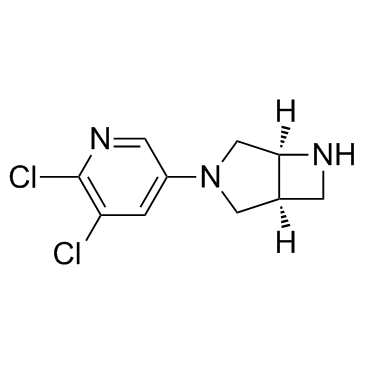799279-80-4
| Name | (1S,5S)-3-(5,6-dichloropyridin-3-yl)-3,6-diazabicyclo[3.2.0]heptane |
|---|---|
| Synonyms |
UNII-SQC232V4YY
Sofinicline ABT-894 ABT 894 |
| Description | Sofiniclin (ABT 894) is an agonist of nicotinic acetylcholine receptor (nAChR), used as a potential non-stimulant treatment for attention-deficit/hyperactivity disorder (ADHD). |
|---|---|
| Related Catalog | |
| In Vitro | Sofiniclin is more potent than ABT-089 at both receptor subtypes, with Ki values of 1.9 nM for 125I-α-conotoxinMII binding and of 1.3 nM for 125I-epibatidine binding[1]. |
| In Vivo | Sofiniclin (0.001 to 0.10 mg/kg, p.o.) produces significant reductions in LIDs compared to vehicle monkey[1]. Sofiniclin (0.1 mg/kg) does not decrease LIDs in monkeys with severe nigrostriatal damage[2]. |
| Kinase Assay | Receptor studies with ABT-089 and Sofiniclin are done using rat striatal sections. α6β2* nAChR levels are assayed using 125I-α-conotoxinMII (α-CtxMII) (specific activity, 2200 Ci/mmol). α4β2* nAChRs are measured by determining the binding of 125I-epibatidine (specific activity, 2200 Ci/mmol) in the presence of 100 nM α-CtxMII to block α6β2* nAChRs. After assay, sections are exposed to Kodak MR film. To evaluate binding, optical density readings are converted fmol/mg tissue using 125I-standards. |
| Animal Admin | Monkeys: Once stable dyskinesias develops, the effects of ABT-089 and Sofiniclin are determined on LIDs. For these studies, there are two sets of MPTP-lesioned monkeys, Set A (n = 17) and Set B (n = 16). Set A monkeys have previously been treated with nicotine and/or nAChR drugs, followed by a 10 week ishout period (nAChR drug-primed). Set B monkeys have not received any nAChR drug when ABT-089 treatment is initiated (nAChR drug-naive). Our rationale for the use of these two sets of monkeys is to determine if prior treatment with nAChR drugs altered their ability to decrease LIDs. For both sets, there are 3 experimental groups of monkeys, a vehicle-treated group (n = 6), a nAChR drug-treated group (n = 5 or 6) and a nicotine-treated group (n = 5), as a positive control. The monkeys are assigned to the groups such that there are similar number of males and females, with comparable average LID scores. |
| References |
| Molecular Formula | C10H11Cl2N3 |
|---|---|
| Molecular Weight | 244.12000 |
| Exact Mass | 243.03300 |
| PSA | 28.16000 |
| LogP | 2.19020 |
